Video is a great way to engage with your audience. It captures their attention and provides information they might miss when skimming your page. Practically any device that’s great for browsing the web is great for playing video. Fortunately, designing a video section for a page or post is a simple process with WordPress. In this post, we’ll explore video section website design to help you get the most out of your videos on your WordPress website.
What is a Video Section in a Website?

A video section is a portion of your website’s pages that’s designed to showcase a video.
The video is usually the primary element of the section, but the section often includes surrounding text, such as a title or a statement. A website can have multiple video sections. The image above shows a portion of a home page from Divi that includes a video section.
Why Include a Video Section in Your Website Design?
Video is a great way to draw attention, making them ideal for marketing your products and services, providing detailed tutorials, and lots more. It’s a great way to provide information and deliver a powerful message.
Videos can make your website and website design more interesting. Videos that play automatically can catch the eye to draw attention. Interesting videos can keep visitors on your website longer, which can increase the chances of a conversion. The play icon can invite your visitors to interact with your website.
Videos can improve sales. Showing how a product works is usually better than telling how a product works. Potential buyers want to see a product in action. Embedding your videos is also a great way to build a following on platforms such as YouTube.
How to Add a Video Section to Your Website Design
There are several ways to add videos to your WordPress pages and posts. You can embed them with HTML or use a WordPress block. A block is the best option for most WordPress users and it’s the method we’ll cover in this post. We’ll also see how to add a video with a page builder.
WordPress includes several video blocks to insert multiple types of videos into your content. Each has styling and layout options, so you can customize them to fit your design. I recommend choosing a block based on the needs of the video and the styling options you prefer.
Videos with small file sizes are easy to load from your media library. For larger file sizes, it might be best to host them on another platform and embed them into your content. This will vary depending on your hosting plan for WordPress and storage space, but it’s almost always best to upload large videos to a video platform.
To find the video blocks, select the plus icon to add a block to your content and search for “video”. You’ll see the first six blocks. To see them all, click Browse All. Some of these blocks allow you to embed videos from specific platforms and are limited in their options. We’ll look at each block and see their features. I’ll embed a video to show their options where possible.
Video
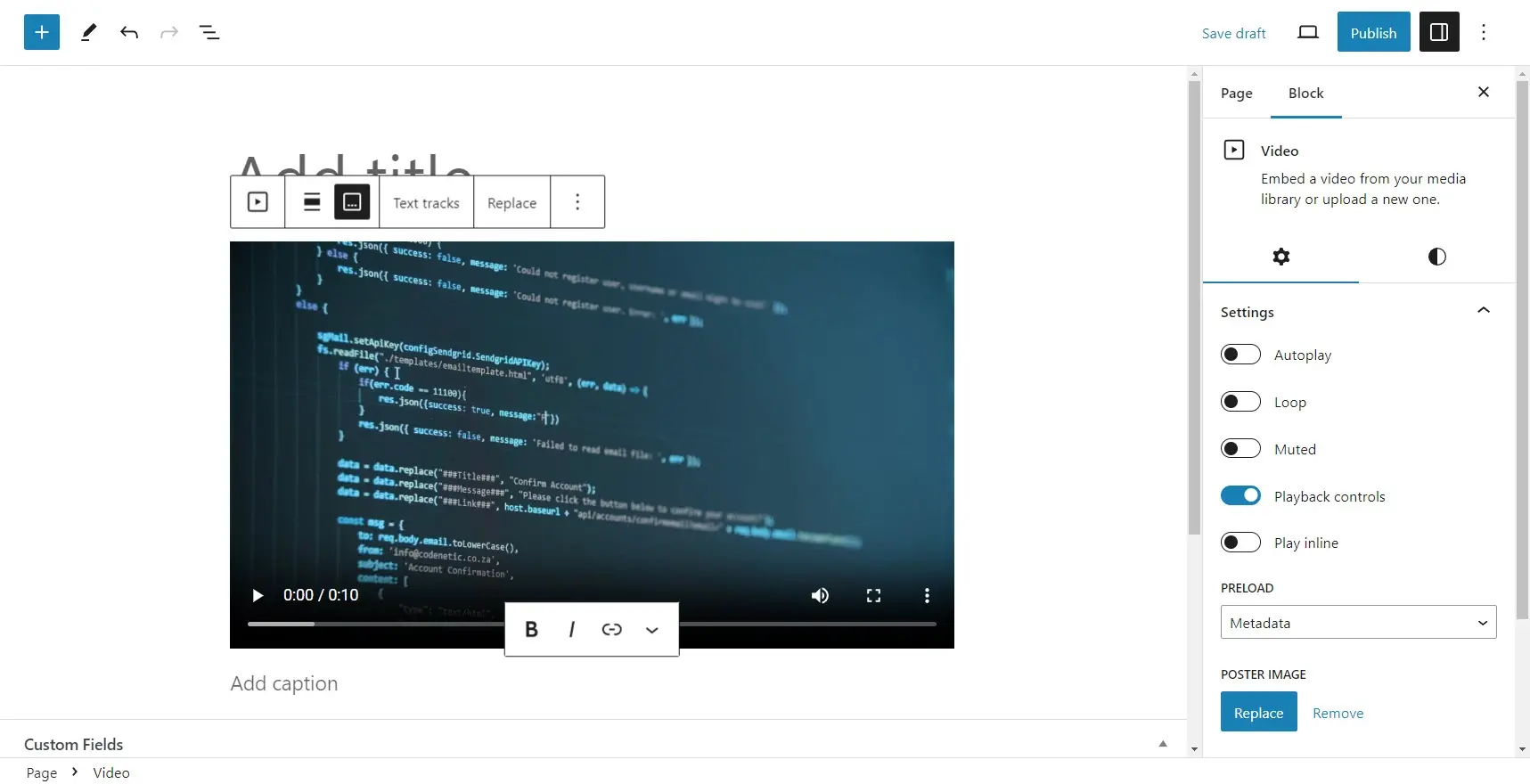
The Video block is a good all-around choice for inserting videos into your pages and posts. It allows you to upload a video to embed from your media library or add a URL to stream the video as needed. Features include play, pause, seek, volume, full screen, download, player speed, and picture-in-picture.
It’s limited in styling options. Add captions, and text tracks, adjust the alignment, and dimensions (padding and margin), add HTML anchors, and include CSS classes. Settings include autoplay, loop, muted, playback controls, play inline, preload, and poster image. This is a good basic video player.
Media & Text

The Media & Text block places media on one side and text on the other. Upload and choose your video from your media library. It has the standard alignment options and adds options to align the media and text. Place the text at the top, middle, or bottom of its area. You can also place media on the left or the right. Stack them on mobile, adjust the media width, add CSS classes, and adjust the color and typography of the text.
This one can only display videos from your media library, so it’s good for small videos that you want to host on your website. The content area makes it a great choice for a CTA or any video that you want to show more than a title or short description.
Cover
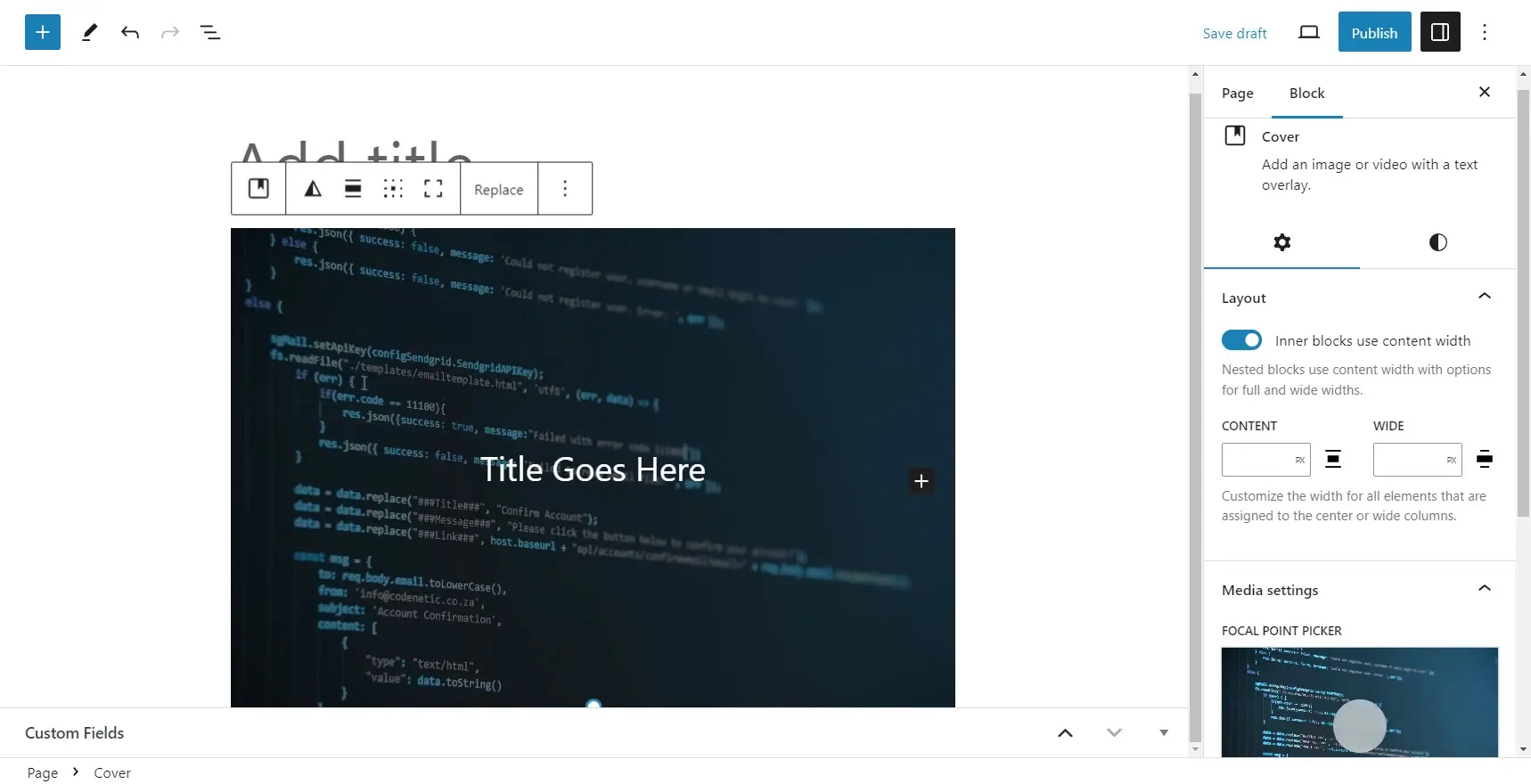
The Cover block lets you add a video with a text overlay to display a title over the media. It includes a customizable overlay, or you can use a featured image. Drag and drop any type of media from your computer or media library. Apply filters, change the position, make full height, customize the text, overlay, and more.
This is a good choice for applying text over the video or controlling the image that is displayed before the user clicks to play the video. This is one of the best video blocks available.
VideoPress
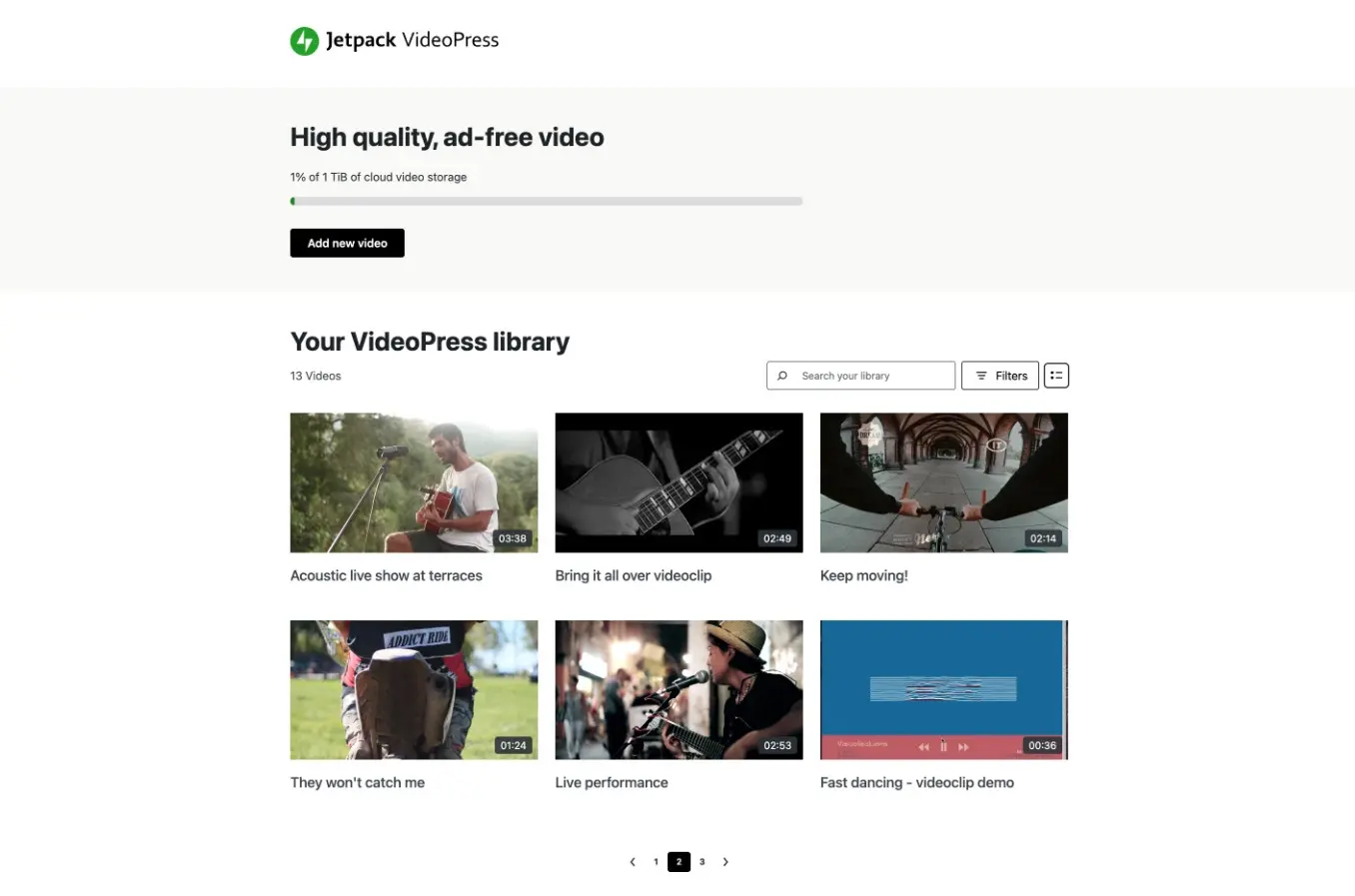
The Jetpack VideoPress block lets you easily embed a video from VideoPress, which is owned by Automattic- the maker of WordPress. Simply enter the URL of the video. The block includes the standard alignment options. Add a title and description, choose the privacy options, share and download options, and choose a rating (choose from G, PG, and PG13). You can adjust the margin and add CSS classes. Users can click the video to play or pause and play audio or mute.
YouTube
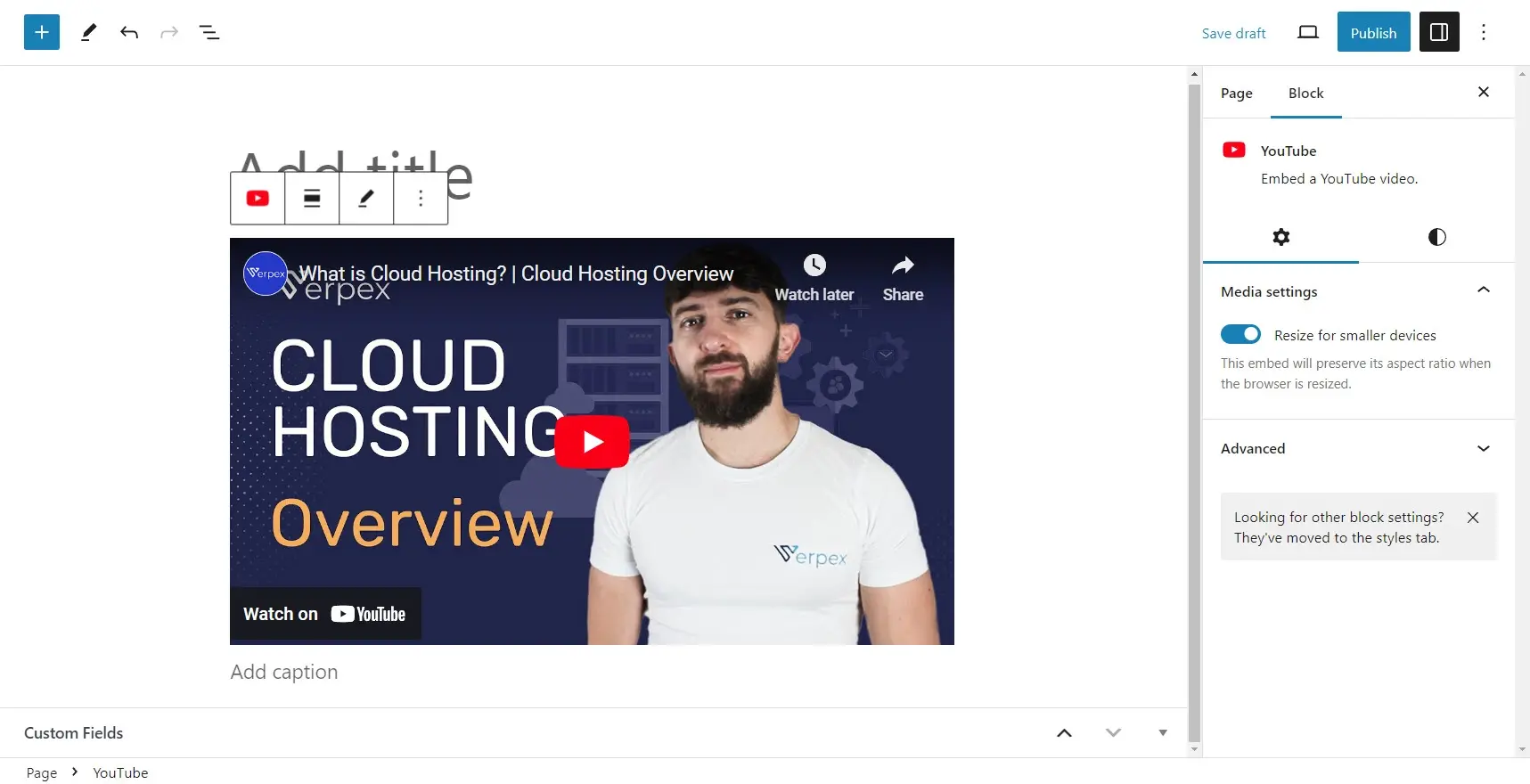
The YouTube block lets you embed any YouTube video by entering the video’s URL. The videos can be posted on YouTube as hidden, so they’ll only show on your website. This allows you to build your audience on your website instead of YouTube if you prefer. It has the standard alignment options, and you can adjust the margin and add CSS classes. You can have it automatically resize on smaller devices. It includes all the standard player controls.
This is one of the best options for displaying videos on your website. YouTube gives you a lot of control over the videos and you don’t have to host them on your website. You have access to lots of features including analytics, player options, restrictions, ads, links, and more. This is especially ideal for large videos.
For more about embedding YouTube videos, see the article How to Embed a YouTube Video in WordPress.
Vimeo
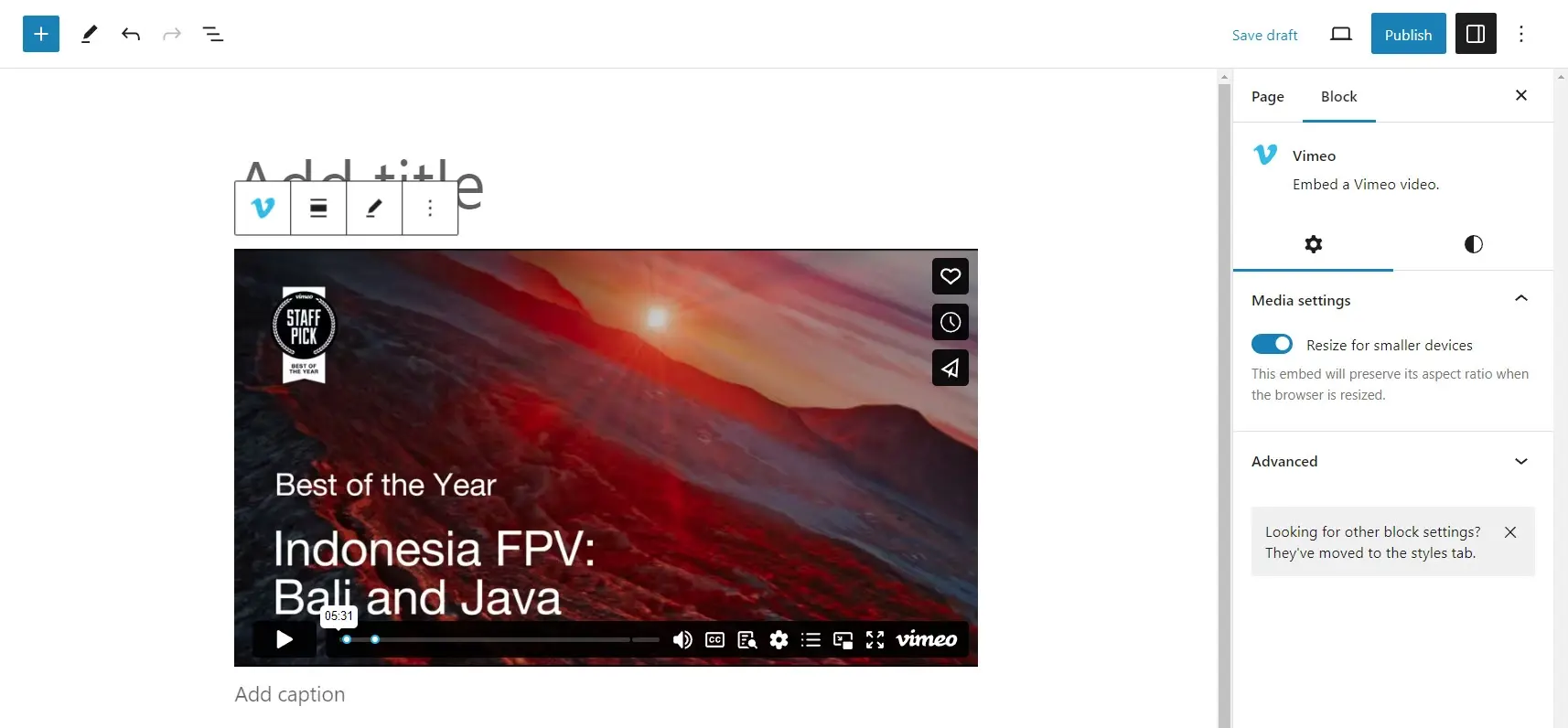
The Vimeo block lets you embed videos from Vimeo. Just paste the URL of the video you want to display. This is a great way to host your videos away from your server and have excellent control over the videos. This block is ideal for anyone who prefers the Vimeo platform. It includes all the standard player controls such as a CC, transcript, chapters, picture-in-picture, and more.
Add a caption at the bottom and adjust the text. It also includes the standard alignment options, and you can make margin adjustments and add CSS classes. You can have it to resize on smaller devices.
Animoto

The Animoto block lets you embed Animoto videos by entering the video’s URL. This block also includes alignment options, margin adjustments, and a field to add CSS classes. The player controls match the WordPress video block. Download the videos to upload to your media library or have Animoto to host them.
Dailymotion
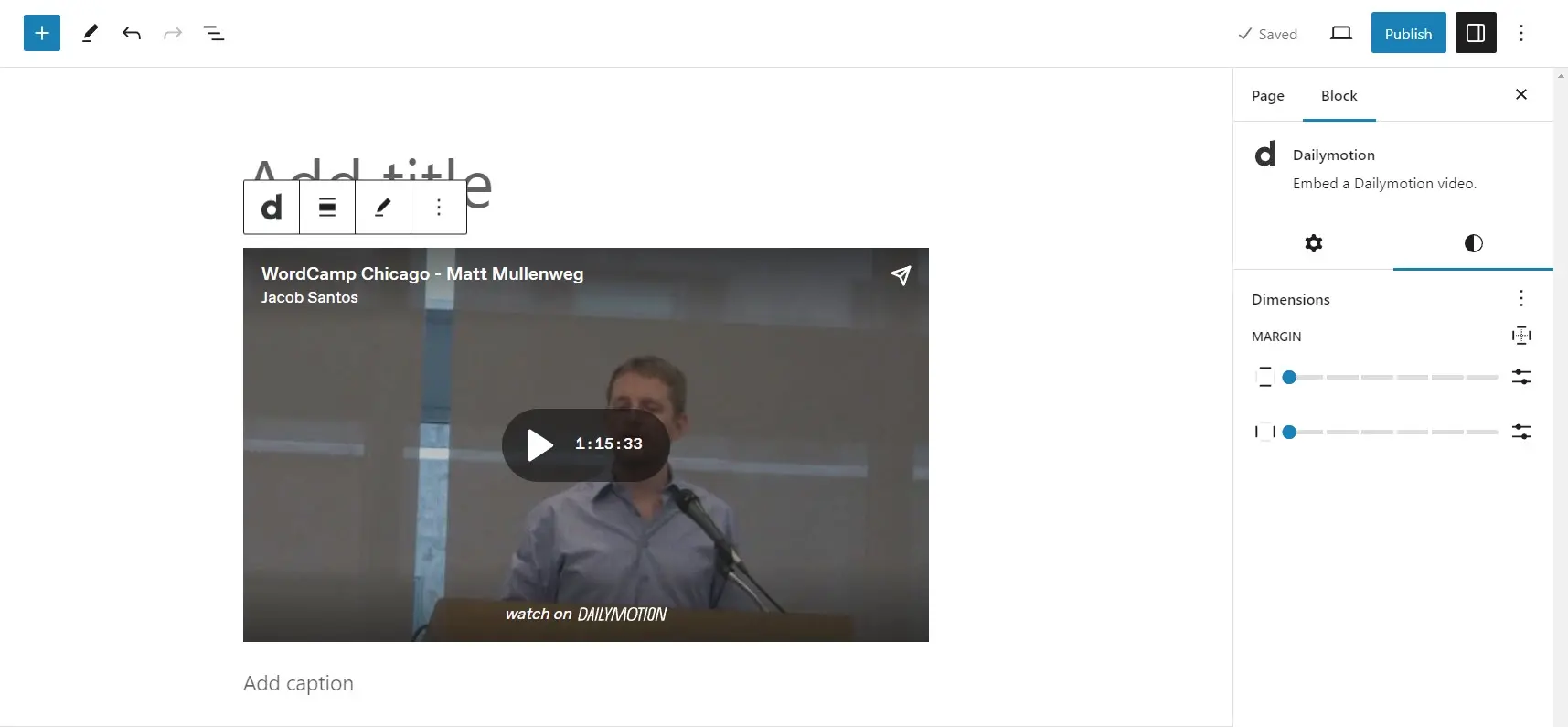
The Dailymotion block lets you embed videos from Dailymotion. Enter the video’s URL to embed the video. It includes alignment options, margin adjustments, and a field to add CSS classes. It includes all the standard player controls, a link to watch the video on Dailymotion’s website, a caption, and you can resize the video for smaller screens.
TikTok
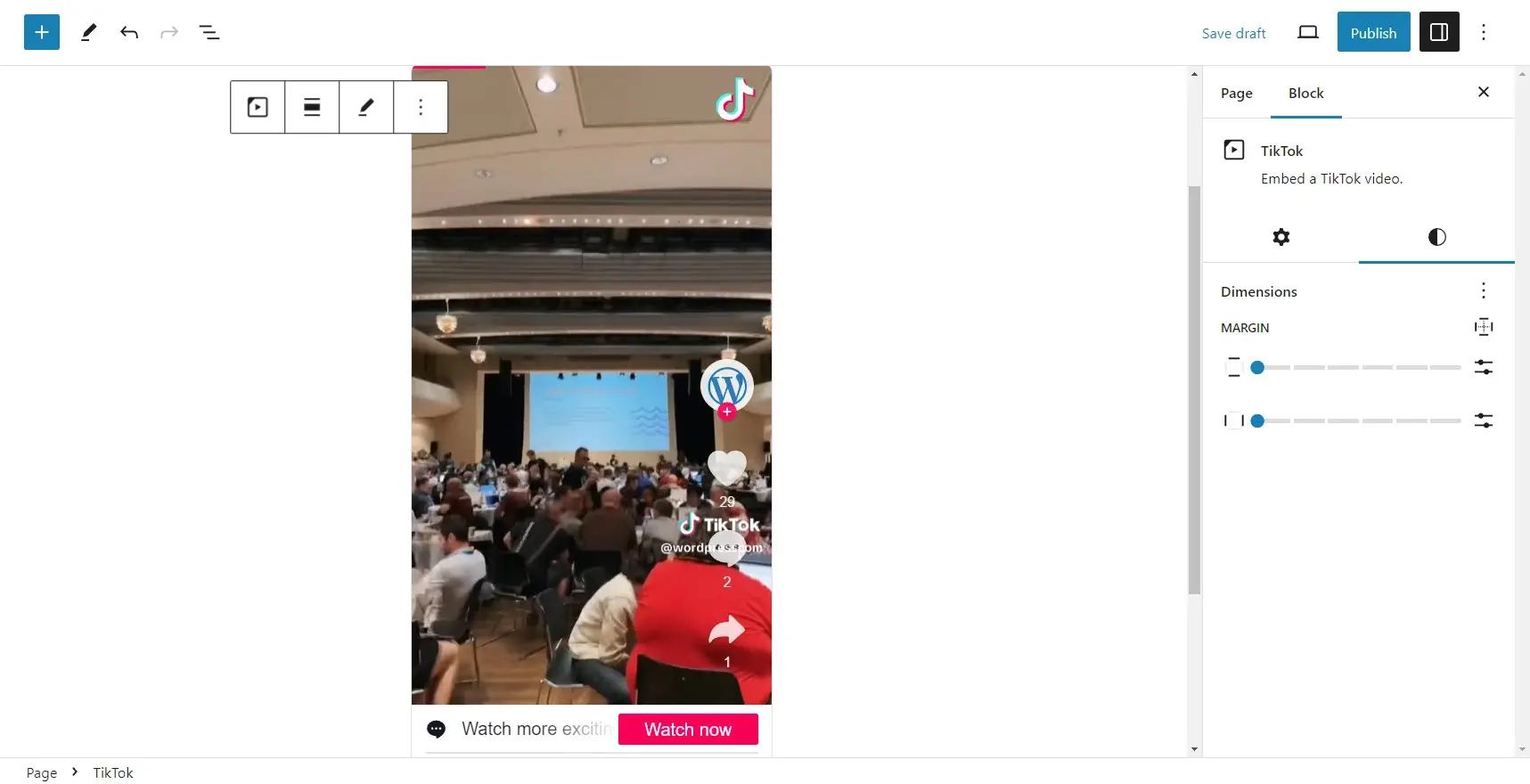
The TikTok block lets you embed videos from TikTok by entering the video’s URL to embed the video. It also includes alignment options, margin adjustments, and a field to add CSS classes. It includes the standard TikTok player controls and includes links and hashtags. You can resize the video for smaller screens.
TED
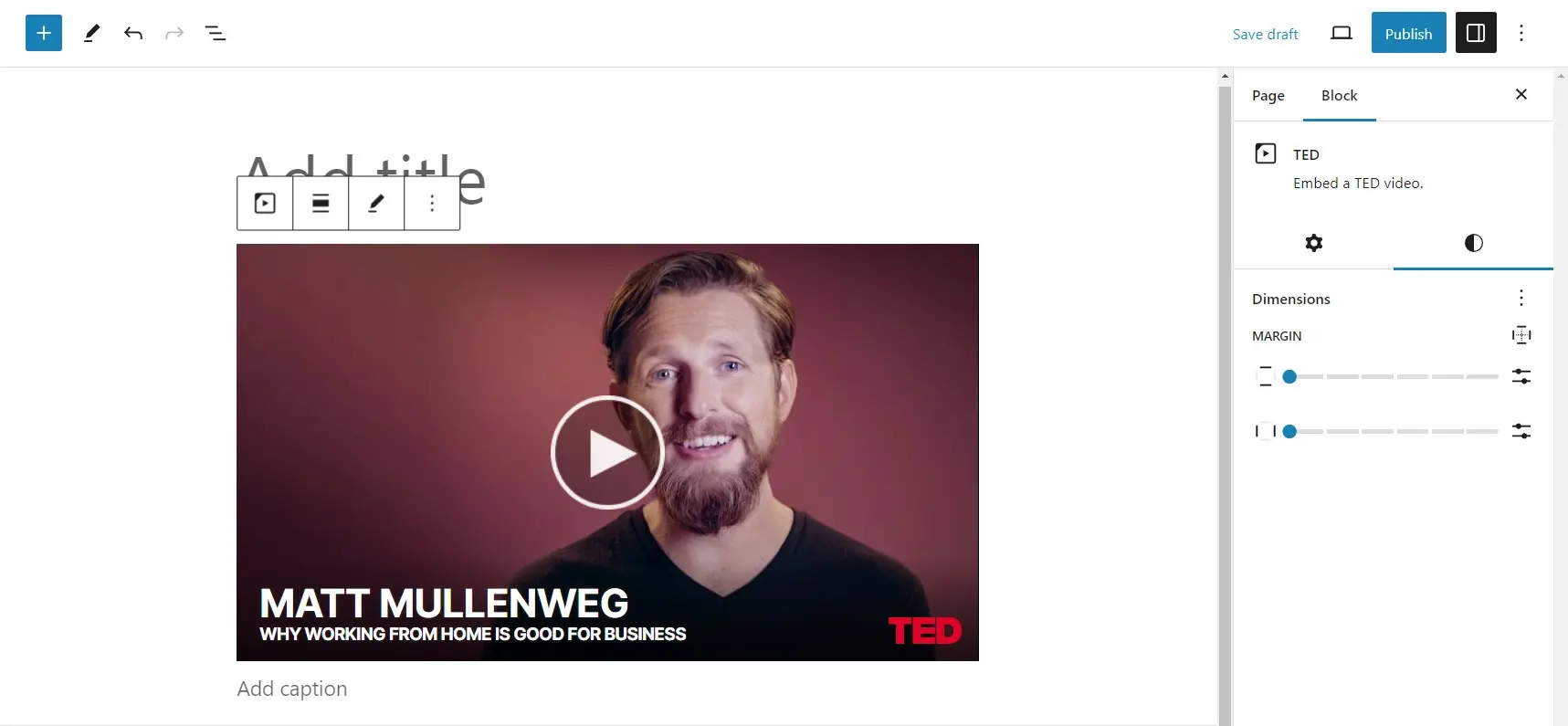
The TED block lets you embed TED videos by entering the video’s URL. It also includes alignment options, margin adjustments, resizing for smaller screens, and a field to add CSS classes. It includes all of the TED player controls and a field to add a caption. The caption does not include text settings.
WordPress.tv
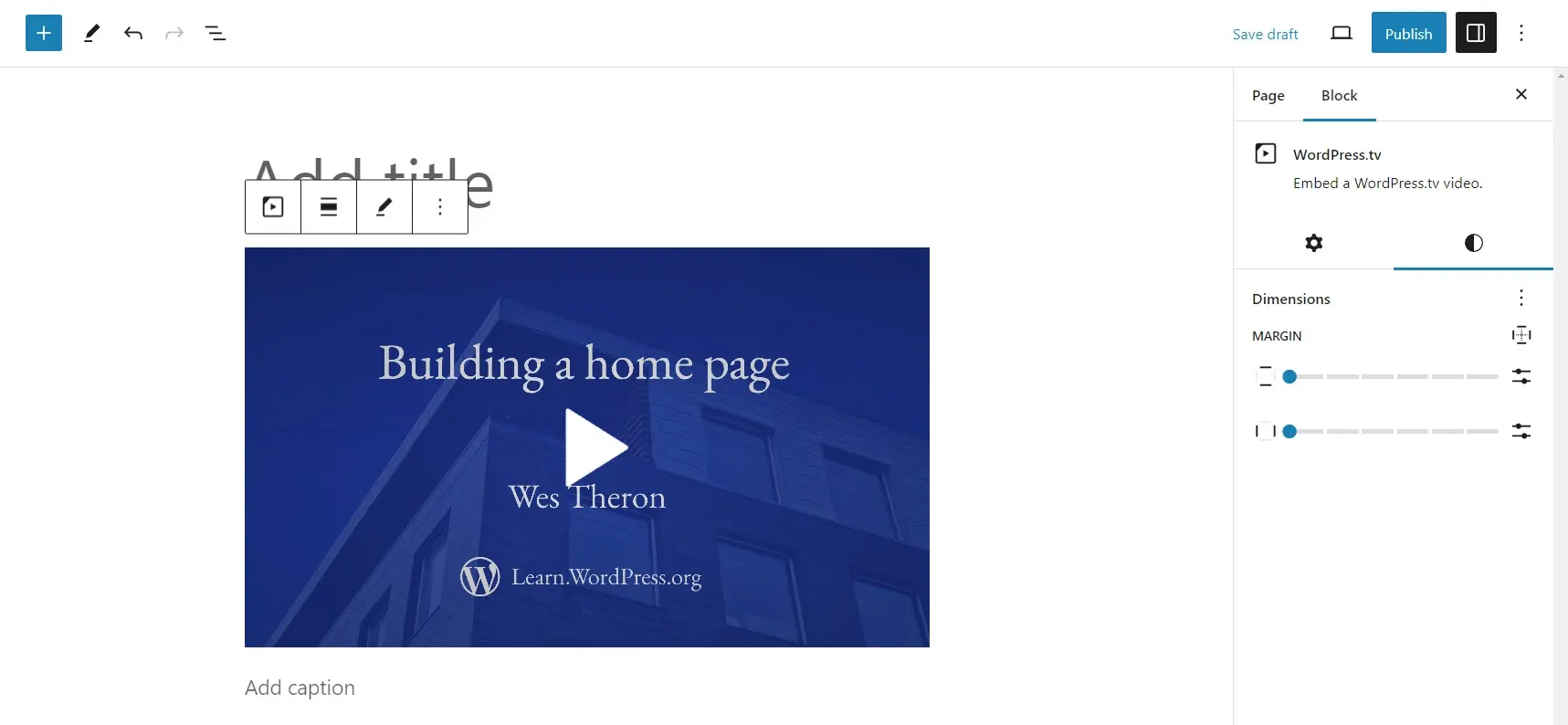
The WordPress.tv block lets you embed videos from WordPress.tv by entering the video’s URL. Options include alignment, margin adjustments, a field to add CSS classes, and an option to resize the video to fit smaller screens. All the standard WordPress.tv player controls are present.
Adding More Video Blocks
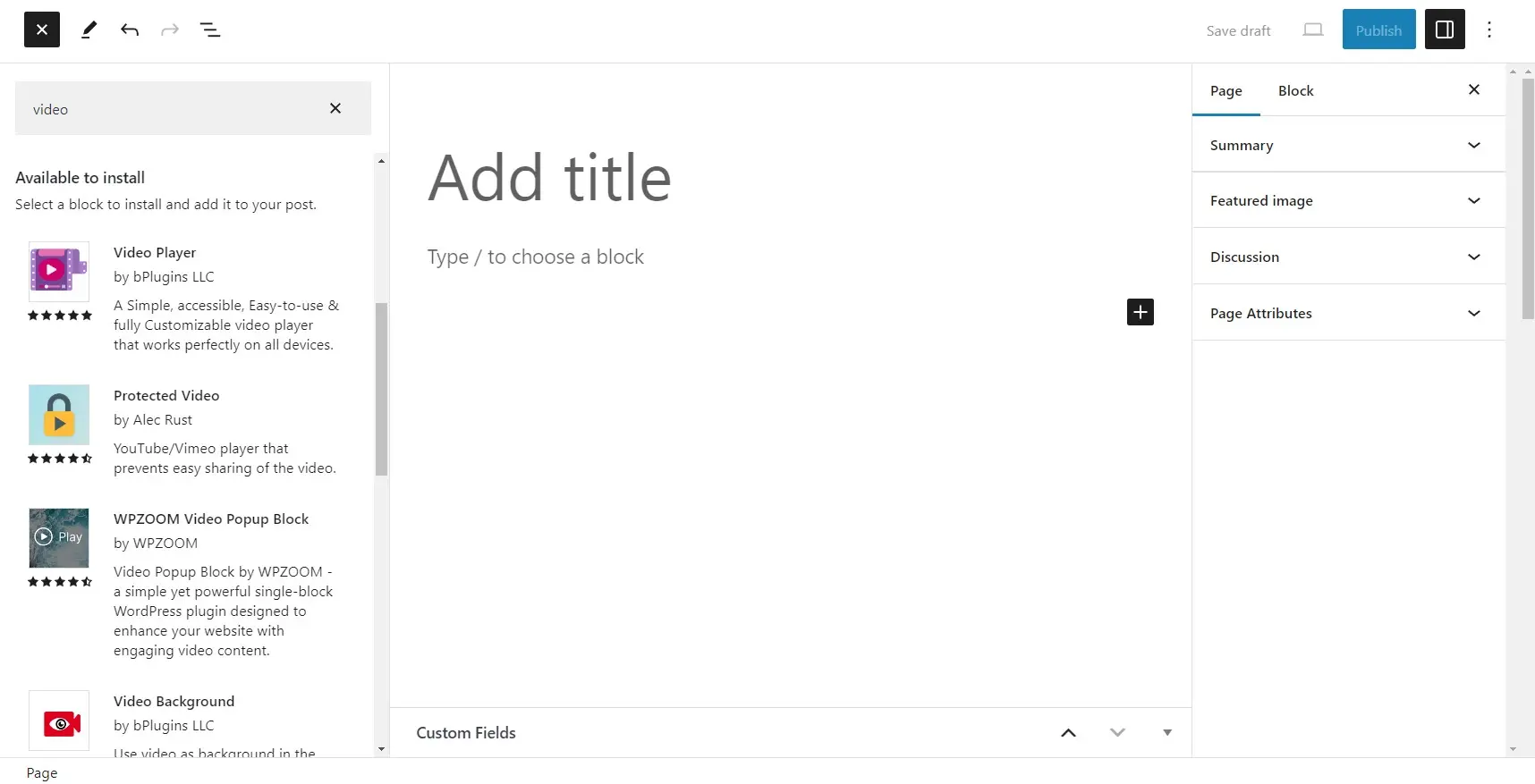
If you want more features or a block that isn’t already built into WordPress, the WordPress search option will also recommend video blocks. Just click on the block you want, and WordPress will add it automatically. Recommended video blocks include:
- Video Player
- Protected Video
- WPZOOM Video Popup Block
- Video Background
- Video Gallery
- Algori Video and Image Slider
- 360 Video
- TomS Video Player
Some of these blocks add new players or features to display your videos in different ways. Many of them add features to protect your videos from being downloaded and shared.
Choosing a Video Block for Your Video Section Website Design
When choosing your video block, look at both the features of the platform and the styling options. Most blocks have limited styling options, but you can style them with CSS classes. The platform can be your media library or a video hosting platform. Hosting them in your media library isn’t a good idea for large video files. Also, you can embed videos from any account that hasn’t blocked the embed feature, so they don’t have to be your videos.
Make sure the video player works the way you want it to work. For example, you might want the video to play automatically, hide player controls, display a featured image, etc. I recommend most users host the video on YouTube or Vimeo and then embed the video into their content. This gives you lots of control over the players and includes lots of features in the background, such as analytics. You can hide the videos so they only show on your website, or you can make them visible and use those platforms to build a following if you want.
Creating a Video Section with Page Builders

Many page builders include a video module that you can drag and drop where you want. They work the same as block but include more styling features. For example, the image above shows Divi with a video module. For more information about Divi, see the article Divi Review.
The Divi video module lets you embed YouTube videos with a URL or display MP4 or WEBM files from your media library. Add an overlay to have full control over the image that displays, or let the module generate an image from the video.
For more about page builders, see the articles 7 Best Drag and Drop WordPress Page Builders and 4 Best Free Page Builders for WordPress.
Video Section Website Design Tips
Style the video with the same website design concepts as all other website elements. This means choosing colors, borders, backgrounds, typography, etc., with UX and UI in mind. Use the right amount of white space and make the video match your branding and goals. For more information about good website design, see the article Brand Consistency in Web Design.
The video section doesn’t need to be the main focus of the page, and you can have more than one video section, but it can support anything you want. Use it to introduce yourself, offer an incentive, promote sales, push a call to action, provide general information, presales information, help, draw attention to your videos, and lots more. Place them on home pages, help pages, shop pages, etc.
Use surrounding text to introduce the section, provide needed links, etc., but allow the video to be the focus of the section. Also, use a video player that simplifies playback and keeps the section uncluttered. Use shadows to make the video pop away from the background.
The background can blend with the rest of the site, or it can be an alternate color to stand out a little, or a contrasting color to stand out a lot. You can also make the video full-screen. You can show just the video, or place text and buttons over the video to use it as a background.
The video should feel like it fits into the design and helps tell the story rather than just randomly added to the page or post. Just like all other elements, videos should be value-added.
For more information about using WordPress blocks, see the article Tips to Use & Customize WordPress Block Patterns. For more information about embedding videos, see the article How to Embed a Video in WordPress (without YouTube).
Ending Thoughts on Video Section Website Design
That’s our look at the video section in website design. adding videos to your pages and posts is a great way to draw attention and provide information. WordPress makes it easy to add videos from your media library or from a different website.
For those working with Craft CMS, consider our Craft CMS hosting solutions. Designed to complement the powerful features of Craft CMS, our hosting ensures optimal performance with advanced server technology and a user-friendly control panel.
We want to hear from you. Do you use a video section in your website design? Let us know about your experience in the comments.
Frequently Asked Questions
Why should I create a website?
There are many reasons why you should create a website if you’re an artist. You can use it to create a place where people can learn about you, talk about your art, or show off your work.
How do I choose a design for my website?
One of the most important things when creating a website for your art is the design. Even though your pieces of art might be amazing, people will leave if your site is hard to navigate. This is why it’s important that the site is easy on the eyes and easy to navigate.
What are the best practices for responsive design in WordPress themes?
Use a mobile-first approach, implement media queries, test across various devices, and prioritize user experience on both desktop and mobile.
Is a website on WordPress safe?
Websites on WordPress are safe, however to avoid hacking keep your website up to date.

Randy A. Brown is a freelance writer from east TN specializing in WordPress and eCommerce. He's a longtime WordPress enthusiast and loves learning new things and sharing information with others. If he's not writing or reading, he's probably playing guitar.
View all posts by Randy A. Brown




















